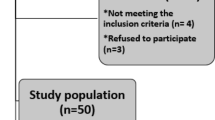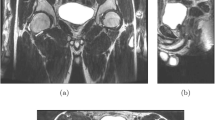Abstract
Background
Magnetic resonance imaging (MRI) is used as a standard for assessment of complex perianal fistulas. Apart from textual description of the case, 3D reconstructed models from MRI further aid in understanding the entire anatomy of the fistula tract and its relation to the pelvic floor. This information is crucial as it helps surgeons to understand the extent and complexity of the disease before surgical treatment. However, 3D model generation from MRI is a time-consuming step for a radiologist as it requires tedious manual delineations to be performed on every slice of the images. The aim of this study was to develop a method that could enable radiologists to present enhanced information to surgeons for treatment of complex perianal fistulas while simultaneously reducing the manual efforts and time required to generate the information.
Methods
A method was proposed to depict relevant anatomies of complex perianal fistula as parametric models in three-dimensional (3D) space. A plugin inside 3D Slicer software was developed for the generation of the parametric models from MRI. The levator ani muscle, internal sphincter, and external sphincter are represented as tubular structures, whereas fistula tracks and abscess are presented as splines.
Results
Parametric models were generated to depict three cases of complex perianal fistulas and similarity measures were computed for ten cases. Visual comparison of the parametric models was made with the 3D models generated by the standard approach. The parametric models took less time to create and were able to visually present enriched information as compared to the 3D models generated by the standard approach.
Conclusions
The proposed method, using parametric models, shows potential for faster generation and better visualization of the 3D information required for the treatment of complex perianal fistula cases.








Similar content being viewed by others
Availability of data and material
The research data are not sharable.
Code availability
The code can be made available upon request to corresponding author.
References
Ramachandra ML, Garg M (2018) A comparative study in the management of fistula in ANO using various modalities. Int Surg J 5(6):2223. https://doi.org/10.18203/2349-2902.isj20182226
Sharma A, Yadav P, Sahu M, Verma A (2020) Current imaging techniques for evaluation of fistula in ano: a review. Egypt J Radiol Nucl Med. https://doi.org/10.1186/s43055-020-00252-9
Davis BR, Kasten KR (2016) Anorectal abscess and fistula. Springer International Publishing, Cham, pp 215–244
Murugesan J, Mor I, Fulham S, Hitos K (2014) Systematic review of efficacy of LIFT procedure in crpytoglandular fistula-in-ano. J Coloproctology 34(02):109–119 (in En)
Parks AG, Gordon PH, Hardcastle JD (1976) A classification of fistula-in-ano. Br J Surg 63(1):1–12. https://doi.org/10.1002/bjs.1800630102
Naik SS, Hanbidge A, Wilson SR (2001) Radiology reports: examining radiologist and clinician preferences regarding style and content. AJR Am J Roentgenol 176(3):591–598. https://doi.org/10.2214/ajr.176.3.1760591 (in En)
Hall JF, Bordeianou L, Hyman N, Read T, Bartus C, Schoetz D, Marcello PW (2014) Outcomes after operations for anal fistula: results of a prospective, multicenter, regional study. Dis Colon Rectum 57(11):1304–1308. https://doi.org/10.1097/DCR.0000000000000216
Rizzo JA, Naig AL, Johnson EK (2010) Anorectal abscess and fistula-in-ano: evidence-based management. Surg Clin North Am 90(1):45–68. https://doi.org/10.1016/j.suc.2009.10.001
Jayarajah U, Samarasekera DN (2017) Predictive accuracy of Goodsall’s rule for fistula-in-ano. Ceylon Med J 62(2):97. https://doi.org/10.4038/cmj.v62i2.8474
Lunniss PJ, Armstrong P, Barker PG, Reznek RH, Phillips RK (1992) Magnetic resonance imaging of anal fistulae. Lancet 340(8816):394–396. https://doi.org/10.1016/0140-6736(92)91472-k (in eng)
Maier AG, Funovics MA, Kreuzer SH, Herbst F, Wunderlich M, Teleky BK, Mittlböck M, Schima W, Lechner GL (2001) Evaluation of perianal sepsis: comparison of anal endosonography and magnetic resonance imaging. J Magn Reson Imaging 14(3):254–260. https://doi.org/10.1002/jmri.1181 (in eng)
Buchanan GN, Halligan S, Bartram CI, Williams AB, Tarroni D, Cohen CR (2004) Clinical examination, endosonography, and MR imaging in preoperative assessment of fistula in ano: comparison with outcome-based reference standard. Radiology 233(3):674–681. https://doi.org/10.1148/radiol.2333031724 (in eng)
Sahnan K, Adegbola SO, Tozer PJ, Patel U, Ilangovan R, Warusavitarne J, Faiz OD, Hart AL, Phillips RKS, Lung PFC (2018) Innovation in the imaging perianal fistula: a step towards personalised medicine. Therap Adv Gastroenterol 11:1756284818775060. https://doi.org/10.1177/1756284818775060 (in eng)
Sousa Júnior EC, Nogueira AT, Rocha BA, Eulálio Filho WMN, Meneses AD (2018) Three-dimensional virtual reconstruction as a tool for preoperative planning in the management of complex anorectal fistulas. J Coloproctology 38(1):77–81. https://doi.org/10.1016/j.jcol.2017.11.002
Sahnan K, Adegbola SO, Tozer PJ, Gupta A, Baldwin-Cleland R, Yassin N, Warusavitarne J, Faiz OD, Hart AL, Phillips RKS, Lung PFC (2018) Improving the understanding of perianal Crohn fistula through 3D modeling. Ann Surg 267(6):e105–e107. https://doi.org/10.1097/SLA.0000000000002629 (in eng)
“3D Slicer Software”. https://www.slicer.org (Accessed 10/12/2020, 2020)
“OsiriX Software”. https://www.osirix-viewer.com (Accessed 10/12/2020, 2020)
“ITK-Snap Software”. http://www.itksnap.org (Accessed 10/12/2020, 2020)
Ramer U (1972) An iterative procedure for the polygonal approximation of plane curves. Comput Graph Image Process 1(3):244–256
Sakoe H, Chiba S (1978) Dynamic programming algorithm optimization for spoken word recognition. IEEE Trans Acoust Speech Signal Process 26(1):43–49
Joyce M, Veniero JC, Kiran RP (2008) Magnetic resonance imaging in the management of anal fistula and anorectal sepsis. Clin Colon Rectal Surg 21(3):213–219. https://doi.org/10.1055/s-2008-1081000 (in eng)
Kuijpers HC, Schulpen T (1985) Fistulography for fistula-in-ano. Is it useful? Dis Colon Rectum 28(2):103–104. https://doi.org/10.1007/BF02552656 (in eng)
de Miguel Criado J, del Salto LG, Rivas PF, del Hoyo LF, Velasco LG, de las Vacas MI, Marco Sanz AG, Paradela MM, Moreno EF (2012) MR imaging evaluation of perianal fistulas: spectrum of imaging features. Radiographics 32(1):175–194. https://doi.org/10.1148/rg.321115040 (in eng)
Gage KL, Deshmukh S, Macura KJ, Kamel IR, Zaheer A (2013) MRI of perianal fistulas: bridging the radiological-surgical divide. Abdom Imaging 38(5):1033–1042. https://doi.org/10.1007/s00261-012-9965-4 (in eng)
Sudoł-Szopińska I, Santoro GA, Kołodziejczak M, Wiaczek A, Grossi U (2021) Magnetic resonance imaging template to standardize reporting of anal fistulas. Tech Coloproctol 25(3):333–337. https://doi.org/10.1007/s10151-020-02384-6
Bradley D, Willson T, Chang JB, Gandolfi B, Zhu TR, Bradley JP, Lee JC (2019) Intraoperative three-dimensional virtual reality and computed tomographic guidance in temporomandibular joint arthroplasty of syndromic craniofacial dysostoses. Plast Reconstr Surg Glob Open 7(9):e2388. https://doi.org/10.1097/gox.0000000000002388 (in eng)
Chugh AJ, Pace JR, Singer J, Tatsuoka C, Hoffer A, Selman WR, Bambakidis NC (2017) Use of a surgical rehearsal platform and improvement in aneurysm clipping measures: results of a prospective, randomized trial. J Neurosurg 126(3):838–844. https://doi.org/10.3171/2016.1.jns152576 (in eng)
Velazco-Garcia JD, Navkar NV, Balakrishnan S, Abi-Nahed J, Al-Rumaihi K, Darweesh A, Al-Ansari A, Christoforou EG, Karkoub M, Leiss EL, Tsiamyrtzis P, Tsekos NV (2021) End-user evaluation of software-generated intervention planning environment for transrectal magnetic resonance-guided prostate biopsies. Int J Med Robot Comput Assist Surg 17(1):1–12. https://doi.org/10.1002/rcs.2179
Velazco-Garcia JD, Navkar NV, Balakrishnan S, Younes G, Abi-Nahed J, Al-Rumaihi K, Darweesh A, Elakkad MSM, Al-Ansari A, Christoforou EG, Karkoub M, Leiss EL, Tsiamyrtzis P, Tsekos NV (2021) Evaluation of how users interface with holographic augmented reality surgical scenes: interactive planning MR-Guided prostate. Int J Med Robot Comput Assist Surg. https://doi.org/10.1002/rcs.2290
Velazco-Garcia JD, Navkar NV, Balakrishnan S, Abinahed J, Al-Ansari A, Darweesh A, Al-Rumaihi K, Christoforou EG, Leiss EL, Karkoub M, Tsiamyrtzis P, Tsekos NV (2020) Evaluation of interventional planning software features for MR-guided transrectal prostate biopsies. In: 2020 IEEE 20th International Conference on Bioinformatics and Bioengineering (BIBE), 26–28 Oct, 2020, pp. 951–954. https://doi.org/10.1109/BIBE50027.2020.00161.
Acknowledgements
The authors would like to acknowledge Kitware Inc. (USA) in developing 3D Slicer software plugin to demonstrate the proposed method of generating parametric models.
Funding
This work was supported by Internal Research Grant Cycle 3 award (IRGC-03-JI-17-080) from Medical Research Center (MRC) at Hamad Medical Corporation (HMC). All opinions, findings, conclusions or recommendations expressed in this work are those of the authors and do not necessarily reflect the views of our sponsors.
Author information
Authors and Affiliations
Corresponding author
Ethics declarations
Conflict of interest
The authors declare that they have no conflict of interest.
Ethics approval
This study was performed in line with the principles of the Declaration of Helsinki. Approval was granted by the institutional review board comprising of the ethical committee (Medical Research Center, Doha, Qatar). Approval number is IRGC-03-JI-17-080.
Consent to participate
Informed consent was obtained from all individual participants included in the study.
Consent for publication
The MR images used in the study were anonymized and do not lead to identification of the subjects in the publication. Consent to publish anonymized data was obtained from the subjects.
Additional information
Publisher's Note
Springer Nature remains neutral with regard to jurisdictional claims in published maps and institutional affiliations.
Rights and permissions
About this article
Cite this article
Navkar, N.V., Balakrishnan, S., Kharbech, S. et al. 3D visualization of perianal fistulas using parametric models. Tech Coloproctol 26, 291–300 (2022). https://doi.org/10.1007/s10151-022-02573-5
Received:
Accepted:
Published:
Issue Date:
DOI: https://doi.org/10.1007/s10151-022-02573-5




